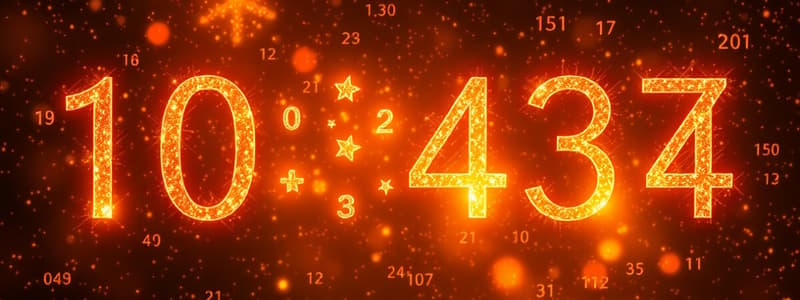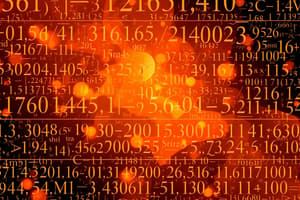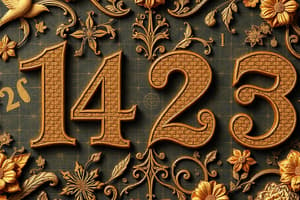Podcast
Questions and Answers
What percentage of the final grade does the final exam account for?
What percentage of the final grade does the final exam account for?
- 15%
- 10%
- 30%
- 40% (correct)
What happens after a student accumulates 6 hours of absence?
What happens after a student accumulates 6 hours of absence?
- They are dismissed from the course. (correct)
- They earn a warning. (correct)
- They need to retake the class.
- They receive a notification.
Which chapters are covered in the first midterm exam?
Which chapters are covered in the first midterm exam?
- Chapters 6, 7, 8, and 9
- Chapters 4, 5, 8, and 9
- Chapters 1, 2, 3, and 4 (correct)
- Chapters 1, 5, 3, and 7
Which of the following is NOT included in the course content?
Which of the following is NOT included in the course content?
How much is classwork and participation worth in the overall grade?
How much is classwork and participation worth in the overall grade?
What is covered under Chapter 1 in the course syllabus?
What is covered under Chapter 1 in the course syllabus?
Which of the following sections is excluded from Chapter 2?
Which of the following sections is excluded from Chapter 2?
What is the purpose of dimensional analysis in solving problems?
What is the purpose of dimensional analysis in solving problems?
What is the density of the sample of iron with dimensions 1.20 cm, 1.30 cm, and 1.20 cm, and mass 1.39 g?
What is the density of the sample of iron with dimensions 1.20 cm, 1.30 cm, and 1.20 cm, and mass 1.39 g?
Using the factor-label method, how would you convert 503.68 g to kilograms?
Using the factor-label method, how would you convert 503.68 g to kilograms?
What volume does 1 liter equal in cubic centimeters?
What volume does 1 liter equal in cubic centimeters?
Which of the following correctly describes dimensional analysis?
Which of the following correctly describes dimensional analysis?
If one foot is equal to 30.48 centimeters, how many centimeters are in 5 feet?
If one foot is equal to 30.48 centimeters, how many centimeters are in 5 feet?
What is the volume in cubic meters for a cube with side lengths of 4 cm?
What is the volume in cubic meters for a cube with side lengths of 4 cm?
What is the conversion factor for converting kilometers to miles?
What is the conversion factor for converting kilometers to miles?
Which calculation correctly converts 7.8 km to miles using dimensional analysis?
Which calculation correctly converts 7.8 km to miles using dimensional analysis?
What does a positive exponent in scientific notation signify?
What does a positive exponent in scientific notation signify?
How would you write the number 0.000456 in scientific notation?
How would you write the number 0.000456 in scientific notation?
If the original number is 2500, what is the correct scientific notation?
If the original number is 2500, what is the correct scientific notation?
When comparing two numbers in scientific notation, what should be compared first?
When comparing two numbers in scientific notation, what should be compared first?
What is the scientific notation for 12340?
What is the scientific notation for 12340?
What does it mean if a number is expressed as 1.23 x 10^-8?
What does it mean if a number is expressed as 1.23 x 10^-8?
How do you convert a negative exponent in scientific notation back to standard form?
How do you convert a negative exponent in scientific notation back to standard form?
Which of the following numbers is the smallest when compared in scientific notation?
Which of the following numbers is the smallest when compared in scientific notation?
What is the scientific notation of 301,786,000?
What is the scientific notation of 301,786,000?
Which of the following represents 0.00234 in scientific notation?
Which of the following represents 0.00234 in scientific notation?
How many significant figures are in the number 150?
How many significant figures are in the number 150?
In the number 0.0200, what is the number of significant figures?
In the number 0.0200, what is the number of significant figures?
What is the standard form of $2.1 \times 10^3$?
What is the standard form of $2.1 \times 10^3$?
Which rule dictates that zeros between significant digits are significant?
Which rule dictates that zeros between significant digits are significant?
What is the scientific notation for 8,706,000?
What is the scientific notation for 8,706,000?
How is the exponent changed for negative scientific notation when inputting into a calculator?
How is the exponent changed for negative scientific notation when inputting into a calculator?
What distinguishes a solid from a liquid in terms of shape?
What distinguishes a solid from a liquid in terms of shape?
Which statement correctly defines a mixture?
Which statement correctly defines a mixture?
In which type of mixture is the composition uniform throughout?
In which type of mixture is the composition uniform throughout?
Which property is characteristic of gases compared to solids and liquids?
Which property is characteristic of gases compared to solids and liquids?
What is the primary difference between atoms and elements?
What is the primary difference between atoms and elements?
Which of the following statements about liquids is correct?
Which of the following statements about liquids is correct?
Which statement is true regarding heterogeneous mixtures?
Which statement is true regarding heterogeneous mixtures?
What is the defining characteristic of a substance in chemistry?
What is the defining characteristic of a substance in chemistry?
Flashcards are hidden until you start studying
Study Notes
Scientific Notation
- Scientific notation is a way to express very large or very small numbers using a number between 1 and 10 multiplied by a power of 10.
- The number between 1 and 10 is called the decimal part, and the power of 10 is called the exponent part.
- A positive exponent means the number is greater than 1, and a negative exponent means the number is less than 1.
- To compare numbers in scientific notation, first compare the exponents. If the exponents are equal, then compare the decimal numbers.
- To convert a number to scientific notation, move the decimal point to obtain a number between 1 and 10. The number of places the decimal point moves determines the power of 10.
- If the decimal point is moved to the left, the exponent is positive.
- If the decimal point is moved to the right, the exponent is negative.
- Converting scientific notation to standard form involves moving the decimal point to the right based on the positive exponent and adding zeros if needed.
- For negative exponents, move the decimal point to the left.
Chemistry 101 syllabus
- The course covers various topics from the textbook "Chemistry 14th edition."
- Sections 1.1 & 1.9, 2.8, 3.4, 4.6 & 4.7, and 24.3 are excluded from the textbook.
- The course grade is based on:
- Midterm exams (30% total)
- Final exam (40%)
- Quizzes (15%)
- Homework (10%)
- Classwork/ Participation (5%)
- The course follows specific attendance policies:
- 3 hours of absence will receive a first warning.
- 6 hours of absence results in a second warning.
- Any absence exceeding 6 hours will result in dismissal from the course.
- Students arriving after 15 minutes will be considered absent, regardless of the rest of the class attendance.
Chapter 1 - Introduction
- The Scientific method is an approach to studying nature.
- It involves making observations, formulating hypotheses, conducting experiments, and drawing conclusions.
- The SI system of measurement is used to express the relationships between quantities.
Chapter 1 - Measurment and properties of Matter
- The density of a substance is calculated by dividing its mass by its volume.
- The factor-label method is used to convert between units by multiplying the original value by a conversion factor
- A conversion factor is a fraction that equals 1 and helps change the units of a measurement.
- Common units and their equivalents are provided for length, mass, and volume.
Significant Figures
- Significant figures represent the precision of a measurement.
- Non-zero digits are always significant.
- Zeros between two significant digits are also significant, while zeros at the beginning of a number are not significant.
- Trailing zeros are significant if the number contains a decimal point.
- Zeros at the end of a number without a decimal point are ambiguous.
Matter and its Properties
- Matter is anything that occupies space and has mass.
- Matter exists in three states: solid, liquid, and gas.
- Solids have fixed shape and volume, while liquids have indefinite shapes and fixed volume. Gases have an indefinite shape and volume.
- The difference in shape and volume is due to the arrangement of atoms or molecules within various states of matter.
Classifications of Matter
- Matter is classified as either pure substances or mixtures
- A substance that cannot be broken down into simpler substances through a chemical process, is called an element.
- A compound is a substance consisting of two or more different elements chemically bonded together.
- A mixture combines two or more substances where each retains its distinct identity and characteristics.
- A homogeneous mixture has the same composition throughout, such as a soft drink.
- A heterogeneous mixture has non-uniform composition, such as soil.
Studying That Suits You
Use AI to generate personalized quizzes and flashcards to suit your learning preferences.




